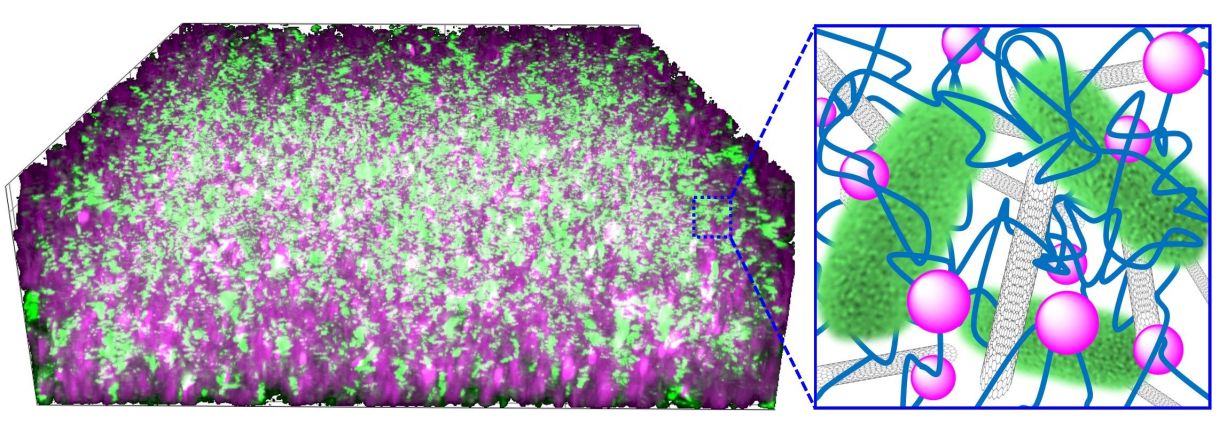Electronic devices are still made of lifeless materials. One day, however, “microbial cyborgs” might be used in fuel cells, biosensors, or bioreactors. Scientists of Karlsruhe Institute of Technology (KIT) have created the necessary prerequisite by developing a programmable, biohybrid system consisting of a nanocomposite and the Shewanella oneidensis bacterium that produces electrons. The material serves as a scaffold for the bacteria and, at the same time, conducts the microbially produced current. The findings are reported in ACS Applied Materials & Interfaces (DOI 10.1021/acsami.9b22116).
The bacterium Shewanella oneidensis belongs to the so-called exoelectrogenic bacteria. These bacteria can produce electrons in the metabolic process and transport them to the cell’s exterior. However, use of this type of electricity has always been limited by the restricted interaction of organisms and electrode. Contrary to conventional batteries, the material of this “organic battery” does not only have to conduct electrons to an electrode, but also to optimally connect as many bacteria as possible to this electrode. So far, conductive materials in which bacteria can be embedded have been inefficient or it has been impossible to control the electric current.
The team of Professor Christof M. Niemeyer has now succeeded in developing a nanocomposite that supports the growth of exoelectrogenic bacteria and, at the same time, conducts current in a controlled way. “We produced a porous hydrogel that consists of carbon nanotubes and silica nanoparticles interwoven by DNA strands,” Niemeyer says. Then, the group added the bacterium Shewanella oneidensis and a liquid nutrient medium to the scaffold. And this combination of materials and microbes worked. “Cultivation of Shewanella oneidensis in conductive materials demonstrates that exoelectrogenic bacteria settle on the scaffold, while other bacteria, such as Escherichia coli, remain on the surface of the matrix,“ microbiologist Professor Johannes Gescher explains. In addition, the team proved that electron flow increased with an increasing number of bacterial cells settling on the conductive, synthetic matrix. This biohybrid composite remained stable for several days and exhibited electrochemical activity, which confirms that the composite can efficiently conduct electrons produced by the bacteria to an electrode.
Such a system does not only have to be conductive, it also must be able to control the process. This was achieved in the experiment: To switch off the current, the researchers added an enzyme that cuts the DNA strands, as a result of which the composite is decomposed.
“As far as we know, such a complex, functional biohybrid material has now been described for the first time. Altogether, our results suggest that potential applications of such materials might even extend beyond microbial biosensors, bioreactors, and fuel cell systems,” Niemeyer emphasizes.
Original Publication:
Yong Hu, David Rehnlund, Edina Klein, Johannes Gescher, Christof M. Niemeyer: „Cultivation of Exoelectrogenic Bacteria in Conductive DNA Nanocomposite Hydrogels Yields a Programmable Biohybrid Materials System”. ACS Applied Materials & Interfaces, DOI 10.1021/acsami.9b22116
Details on the KIT Materials Center:: www.materials.kit.edu/index.php
Further materials:
Publication in ACS Applied Materials & Interfaces: https://pubs.acs.org/doi/10.1021/acsami.9b22116
In close partnership with society, KIT develops solutions for urgent challenges – from climate change, energy transition and sustainable use of natural resources to artificial intelligence, sovereignty and an aging population. As The University in the Helmholtz Association, KIT unites scientific excellence from insight to application-driven research under one roof – and is thus in a unique position to drive this transformation. As a University of Excellence, KIT offers its more than 10,000 employees and 22,800 students outstanding opportunities to shape a sustainable and resilient future. KIT – Science for Impact.

